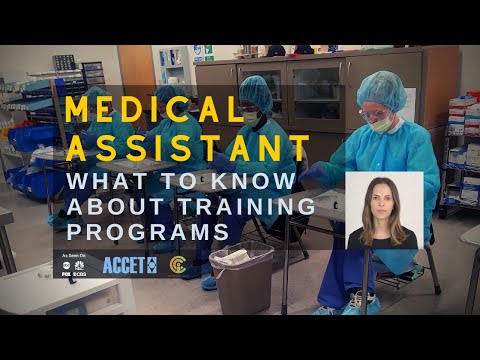Medical Assisting Courses – What You Need to Know
Contents
- Introduction to medical assisting courses
- What do medical assisting courses cover?
- What are the benefits of taking medical assisting courses?
- Who should take medical assisting courses?
- When should you take medical assisting courses?
- How long do medical assisting courses last?
- What is the cost of medical assisting courses?
- What are the prerequisites for medical assisting courses?
- What are the requirements to become a certified medical assistant?
- What are the job outlook and salary for medical assistants?
Medical Assisting courses prepare students for a career in the medical field. Find out what you need to know about these courses.
Checkout this video:
Introduction to medical assisting courses
Medical assisting courses are designed to provide students with the knowledge and skills necessary to perform the duties of a medical assistant Medical assistants work in physicians’ offices and other outpatient healthcare facilities. They are responsible for a variety of clinical and administrative tasks, including taking medical histories and recording vital signs, preparing patients for examination, assisting the physician during the examination, performing routine laboratory tests, scheduling appointments, and billing patients.
The majority of medical assistants have completed a postsecondary education program that lasts anywhere from several months to two years. However, some medical assistants may be able to find entry-level positions with only a high school diploma or equivalent. There are also a limited number of certificate programs that last around 12 weeks that may be an option for those who already have a high school diploma or equivalent and do not wish to pursue a longer program.
What do medical assisting courses cover?
Medical assisting courses cover a wide range of topics, from medical billing and coding to administrative duties such as scheduling appointments and managing medical records In order to become a certified medical assistant you must complete an accredited program that includes both classroom and clinical training.
While the specific curriculum may vary from one school to the next, most medical assistant programs will cover the following topics:
-Anatomy and Physiology: Medical assistants need to have a basic understanding of human anatomy and physiology in order to perform their duties effectively.
–Medical Terminology Medical assistants need to be able to understand and use medical terminology in both written and oral communications.
-Clinical Procedures: Medical assistants must be able to perform basic clinical procedures, such as taking patient vital signs, administering injections, and conducting routine laboratory tests.
-Pharmacology: Medical assistants need to have a basic understanding of how drugs work in order to properly administer medications.
-Medical Office Procedures: Medical assistants must be familiar with common office procedures, such as scheduling appointments and ordering supplies.
-Medical Law and Ethics: Medical assistants need to understand the legal and ethical implications of their work in order to protect both patients and themselves.
What are the benefits of taking medical assisting courses?
The medical assisting field is projected to grow much faster than average in the coming years, making it a great career choice for those interested in the medical field. In order to become a medical assistant, you will need to complete an accredited medical assisting program, which will provide you with the education and training necessary to perform the job effectively.
There are many benefits to taking medical assisting courses, including:
-You will learn about the various aspects of the job, including both administrative and clinical duties.
-You will gain hands-on experience in a variety of medical settings.
-You will be able to take the MA certification exam upon completion of your program, which will give you a competitive edge when applying for jobs.
If you are interested in pursuing a career as a medical assistant, be sure to research accredited medical assisting programs in your area.
Who should take medical assisting courses?
Anyone who wants to pursue a career in medical assisting should take medical assisting courses. These courses will provide you with the knowledge and skills you need to perform your job effectively.
There are a few different ways to become a medical assistant. You can earn a certificate or diploma from a postsecondary institution, or you can complete an accredited training program. There are also some states that require medical assistants to be licensed or certified.
Regardless of how you choose to become a medical assistant, taking medical assisting courses is essential. These courses will teach you about the duties of a medical assistant, the medical terminology used in the field, and the different procedures you will be responsible for performing.
When should you take medical assisting courses?
Medical assisting courses are designed to prepare individuals for a career in the medical field. Although there is no specific time frame in which these courses must be taken, it is generally recommended that students complete them prior to beginning their career in the medical field. This way, they will have the knowledge and skills necessary to perform their duties effectively.
How long do medical assisting courses last?
The length of medical assisting courses varies depending on the program you choose and the type of certification you are seeking. Most certificate programs can be completed in about a year, while Associate’s degree programs generally take two years to finish.
While curriculum varies by school, most medical assisting courses will cover topics such as medical billing and coding, anatomy and physiology, patient relations, and administrative tasks such as scheduling appointments. You will also likely have the opportunity to participate in an externship, which will give you real-world experience working in a medical office or another healthcare setting.
What is the cost of medical assisting courses?
Medical assisting courses can range in cost depending on the type of course, institute, and location. The average cost of a medical assisting course is $1,500. However, there are many free and low-cost options available. There are also many scholarships and financial aid options available to help offset the cost of medical assisting courses.
What are the prerequisites for medical assisting courses?
Before enrolling in medical assisting courses, you will need to complete certain prerequisites. These may vary depending on the program you choose, but they typically include classes in biology, anatomy, and physiology. You will also need to complete a criminal background check and have up-to-date immunizations.
What are the requirements to become a certified medical assistant?
There are several different routes you can take to become a certified medical assistant, but most will require completing an accredited training program and passing a certification exam. Some states also have additional licensure requirements.
The most common way to become a certified medical assistant is to complete an accredited training program. These programs are typically offered at community colleges, technical schools, and some hospitals. They typically last between six and eighteen months and include both classroom instruction and hands-on training.
After completing a training program, you will then need to pass a certification exam. The most common exams for medical assistants are the Certified Medical Assistant (CMA) exam administered by the American Association of Medical Assistants (AAMA) and the Registered Medical Assistant (RMA) exam administered by the American Medical Technologists (AMT). There are also a number of other certification exams that are available, but these two are the most widely recognized.
Once you have passed a certification exam, you will then need to maintain your certification by completing continuing education credits on a regular basis. Most certification organizations require that you complete at least thirty credits every three years in order to remain certified.
What are the job outlook and salary for medical assistants?
The job outlook for medical assistants is very good. Employment of medical assistants is projected to grow 29 percent from 2019 to 2029, much faster than the average for all occupations. The growth of the aging baby-boom generation will continue to increase demand for preventive medical services, which are often provided by medical assistants.
Or https://www.bls.gov/ooh/healthcare/medical-assistants.htm#tab-6
Aspiring medical assistants should complete a formal education program, which is available from community colleges, technical schools, and vocational schools. Most of these programs take about 1 year to complete and result in a certificate or diploma. Some programs may take up to 2 years to complete and lead to an associate’s degree.







